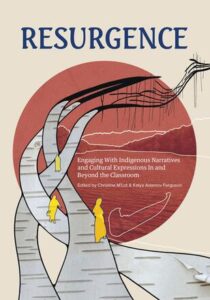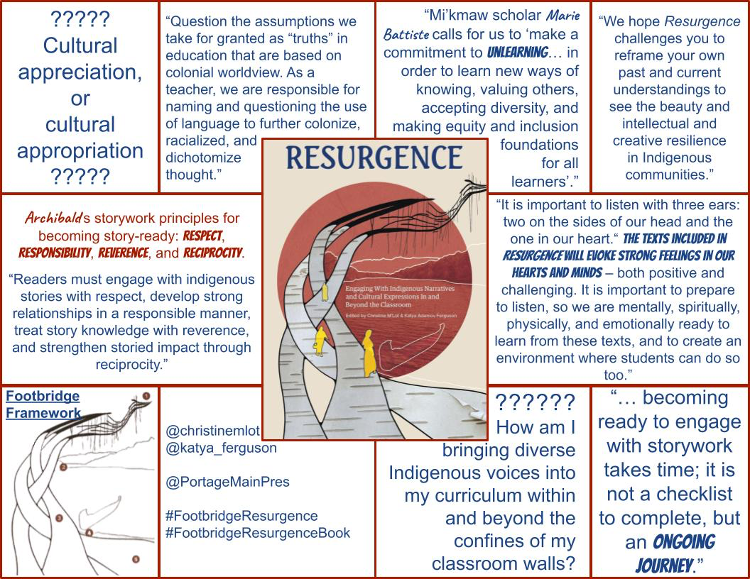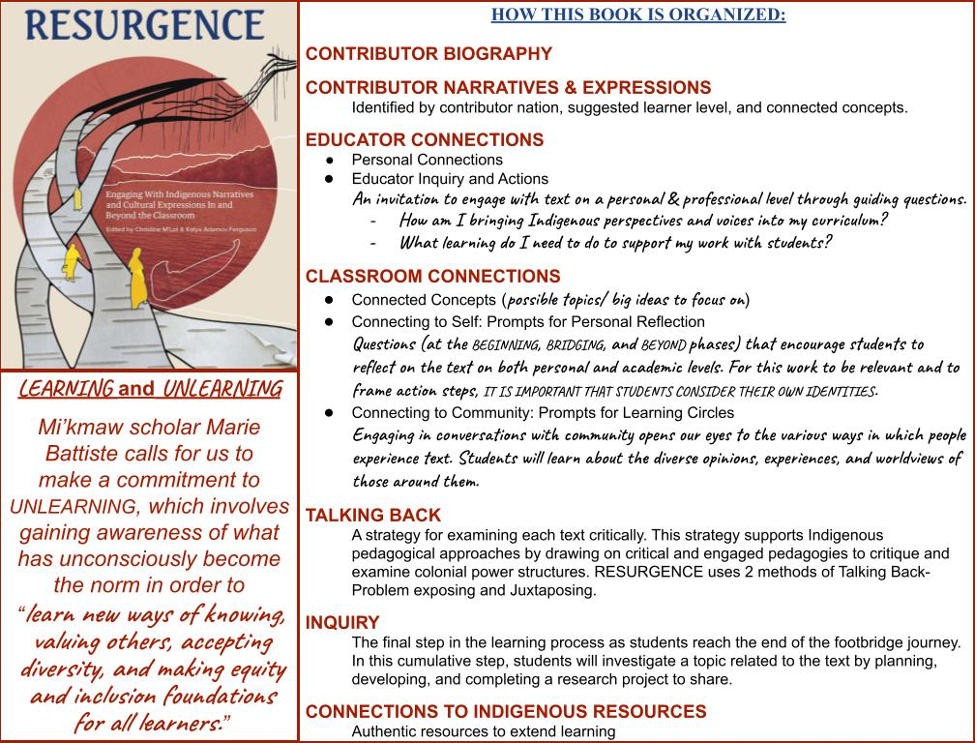Accessing Indigenous Narratives and Culture
Resurgence: Engaging With Indigenous Narratives and Cultural Expressions In and Beyond the Classroom
Edited by Christine M’Lot and Katya Adamov Ferguson
(Portage and Main Press, 2022 – Learn more)
Reviewed by Sherry Liptak
 “I am privileged to live, work, and play on the Stó:lō unceded traditional territory of the Pilalt, Ts’elxweyeqw, and Semá:th tribes.”
“I am privileged to live, work, and play on the Stó:lō unceded traditional territory of the Pilalt, Ts’elxweyeqw, and Semá:th tribes.”
I support about 20 classes of students ranging from kindergarten to grade 5. I am technically accountable for the English growth (and hopefully home language connections!) of about 65 multilingual learners.
In practice, I support any student who needs it in the classes of the multilingual learners I am accountable to. I generally support each class for a block of 30-45 minutes, only once each week.
 I was excited to come across the book, Resurgence: Engaging With Indigenous Narratives and Cultural Expressions In and Beyond the Classroom. I believe that many educators fully embrace Truth & Reconciliation, but some hesitate because they are fearful of how to begin.
I was excited to come across the book, Resurgence: Engaging With Indigenous Narratives and Cultural Expressions In and Beyond the Classroom. I believe that many educators fully embrace Truth & Reconciliation, but some hesitate because they are fearful of how to begin.
I think some educators hesitate to bring more Indigenous resources into their classrooms because they don’t know how to find authentic and meaningful Indigenous resources.
This book is FULL of authentic and meaningful Indigenous resources. They are vibrant, raw, and eye-opening. Some are not easy to read, and I think that makes them more meaningful… necessary. Even if you don’t bring them into your classroom, these stories should change the way to plan your lessons and the way you accept the status quo as “truth.”

Classroom connections
I really appreciate the way this book is organized. On pages 21-23 there is a chart that outlines each text, its contributor, the contributor’s nation, the title and type of text, as well as a suggested learner level and connected concepts (themes). This book is divided into sections focusing on: 1. RESISTANCE, 2. RESILIENCE, 3. RESTORING, and 4. RECONNECTING. Each text is laid out in a format that I found to help soothe the nerves of delving into such important work.
This text will show the reader how to take care before delving in. The editors will be open and make themselves vulnerable by sharing their insights and offering questions to guide inquiry. Each text comes with classroom connections that include prompts for learning circles and prompts for personal reflection. Each text of this book comes with an invitation to think critically and examine colonial power structures. Each text invites readers (teachers and/ or students) to investigate a topic related to the text and share findings somehow. Each text includes connections to authentic and meaningful Indigenous resources at the end.

UNLEARN then LEARN
Section 1 has texts along the theme of RESISTANCE. The reader is asked to “UNLEARN and LEARN – to unlearn the racism and superiority so evident in our society and to learn new ways of knowing, valuing others, accepting diversity, and making equity and inclusion foundations for all learners.”
Section 2 has texts along the theme of RESILIENCE. The reader is asked to “take responsibility for learning more about…” and to “honour the bravery and vulnerability that is needed to share one’s struggles openly.” I think of “resilience” as the ability to overcome adversity, and as I work through this section, I think about how to build resilience in my students as my heart breaks at the need for it.
Section 3 has texts along the theme of RESTORING and “explores the idea of stories translating to and through writing and representation in contemporary culture and media, intergenerational stories, physical environments and places, and digital spaces.” This section is really opening my eyes as to the power of media. I am watching a TV series now and becoming offended by the discrepancies. I am also wondering at the authenticity. Now my wondering isn’t the end of it. Now I am driven to research, ask questions, look deeper.
Section 4 has texts along the theme of RECONNECTING and “offers reminders of how to reconnect ideas, practices, and works to bridge personal experiences and professional practices.”
An invitation to join the journey
This book is NOT A CHECKLIST NOR A TEMPLATE OF A LESSON PLAN. This book is an invitation to dive deeply into authentic and meaningful Indigenous resources. This book asks its readers to get their hands dirty, to become an upstander, to join the path – to prepare yourself first, then walk along with your students. This book invites its readers to begin the work of being an ally along the journey towards reconciliation.
“I am privileged to LEARN, live, work, and play on the Stó:lō unceded traditional territory of the Pilalt, Ts’elxweyeqw, and Semá:th tribes.”
Sherry Liptak (@SherryTeacher on Twitter) District has been a teacher of multilingual learners and their classes in Chilliwack, BC, Canada since 2011. “I am tenacious in the pursuit of self-directed professional development so I can be a great teacher of, and advocate for, multilingual students.”






























